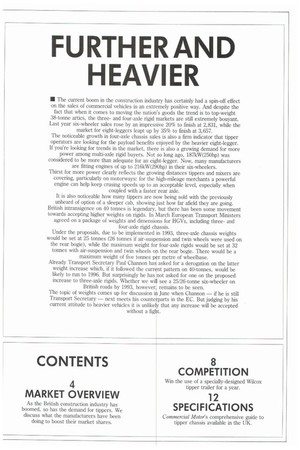FURTHERAND HEAVIER
Page 119

If you've noticed an error in this article please click here to report it so we can fix it.
• The current boom in the construction industry has certainly had a spin-off effect on the sales of commercial vehicles in an extremely positive way. And despite the fact that when it comes to moving the nation's goods the trend is to top-weight 38-tonne artics, the threeand four-axle rigid markets are still extremely bouyant. Last year six-wheeler sales rose by an impressive 20% to finish at 2,831, while the market for eight-leggers leapt up by 35% to finish at 3,657. The noticeable growth in four-axle chassis sales is also a firm indicator that tipper operators are looking for the payload benefits enjoyed by the heavier eight-legger. If you're looking for trends in the market, there is also a growing demand for more power among multi-axle rigid buyers. Not so long ago, 187kW(250hp) was considered to be more than adequate for an eight-legger. Now, many manufacturers are fitting engines of up to 216kW(290hp) in their six-wheelers. Thirst for more power clearly reflects the growing distances tippers and mixers are covering, particularly on motorways: for the high-mileage merchants a powerful engine can help keep crusing speeds up to an acceptable level, especially when coupled with a faster rear axle. It is also noticeable how many tippers are now being sold with the previously unheard of option of a sleeper cab, showing just how far afield they are going. British intransigence on 40 tonnes is legendary, but there has been some movement towards accepting higher weights on rigids. In March European Transport Ministers agreed on a package of weights and dimensions for HGVs, including threeand four-axle rigid chassis. Under the proposals, due to be implemented in 1993, three-axle chassis weights would be set at 25 tonnes (26 tonnes if air-suspension and twin wheels were used on the rear bogie), while the maximum weight for four-axle rigids would be set at 32 tonnes with air-suspension and twin wheels on the rear bogie. There would be a maximum weight of five tonnes per metre of wheelbase. Already Transport Secretary Paul Channon hag asked for a derogation on the latter weight increase which, if it followed the current pattern on 40-tonnes, would be likely to run to 1996. But surprisingly he has not asked for one on the proposed increase to three-axle rigids. Whether we will see a 25/26-tonne six-wheeler on British roads by 1993, however i remains to be seen. The topic of weights comes up for discussion in June when Channon — if he is still Transport Secretary — next meets his counterparts in the EC. But judging by his current attitude to heavier vehicles it is unlikety that any increase will be accepted without a fight.
















































































































































